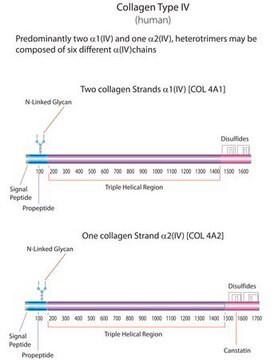234138
Human Collagen Type I
from human skin, powder
Sinónimos:
Collagen, Type I, Human Skin
Iniciar sesiónpara Ver la Fijación de precios por contrato y de la organización
About This Item
Productos recomendados
product name
Collagen, Type I, Human Skin,
assay
≥95% (SDS-PAGE)
Quality Level
form
lyophilized
manufacturer/tradename
Calbiochem®
storage condition
OK to freeze
impurities
≤0.1% subdermal hair
solubility
acetic acid: 5 mg/mL (0.5M)
shipped in
ambient
storage temp.
2-8°C
General description
Collagen type 1 is a fibrillar collagen present abundantly in skin, bone, vasculature, and calcified tissues of teeth and bone. It is also seen in organs like the heart and lungs. Collagen type 1 is a heterotrimer consisting of two α1 (CIα1) and one α2 (CIα2) chains with a helical region made of repeating units of proline and hydroxyproline.
Application
Collagen Type I, Human Skin has been used as a skin protein to study the effect of age-related NADH oxidase (ar-NOX)-catalyzed oxidation on skin proteins. It has also been used as a control sample in High-resolution mass spectrometry (HRMS) analysis.
Biochem/physiol Actions
Collagen type 1 is a main component of the dermal extracellular matrix (ECM) and participates in skin elasticity. Mutations in collagen type 1 are associated with osteogenesis imperfecta and Ehlers–Danlos syndrome.
Warning
Toxicity: Standard Handling (A)
Physical form
Salt-free.
Preparation Note
Prepared from tissue of individuals that have been shown by certified tests to be negative for HBsAg and for antibodies to HIV and HCV.
Reconstitution
The recommended concentration is 0.01 to 0.5 M Acetic Acid (or another acidic buffer), with a maximum concentration of 5 mg/ml. The product has been tested at 0.5 M Acetic Acid and is stable for 1 month at 2-8°C. After reconstitution, aliquot and freeze at -20°C. Stock solutions remain stable for up to 6 months at this temperature.
Other Notes
Gallop, P.M., and Siefert, S. 1963. Methods Enzymol. 6, 635.
Legal Information
CALBIOCHEM is a registered trademark of Merck KGaA, Darmstadt, Germany
Disclaimer
RESEARCH USE ONLY. This product is regulated in France when intended to be used for scientific purposes, including for import and export activities (Article L 1211-1 paragraph 2 of the Public Health Code). The purchaser (i.e. enduser) is required to obtain an import authorization from the France Ministry of Research referred in the Article L1245-5-1 II. of Public Health Code. By ordering this product, you are confirming that you have obtained the proper import authorization.
Storage Class
11 - Combustible Solids
wgk_germany
WGK 1
flash_point_f
Not applicable
flash_point_c
Not applicable
Certificados de análisis (COA)
Busque Certificados de análisis (COA) introduciendo el número de lote del producto. Los números de lote se encuentran en la etiqueta del producto después de las palabras «Lot» o «Batch»
¿Ya tiene este producto?
Encuentre la documentación para los productos que ha comprado recientemente en la Biblioteca de documentos.
Vitamin C-squalene bioconjugate promotes epidermal thickening and collagen production in human skin.
R Gref et al.
Scientific reports, 10(1), 16883-16883 (2020-10-11)
Vitamin C (Vit C) benefits to human skin physiology notably by stimulating the biosynthesis of collagen. The main cutaneous collagens are types I and III, which are less synthesized with aging. Vit C is one of the main promotors of
structure, function, and biomarkers
Biochemistry of Collagens, Laminins and Elastin (2019)
Collagen type I as a ligand for receptor-mediated signaling
Frontiers in physics, 5, 12-12 (2017)
Xing Xu et al.
BMC biotechnology, 11, 69-69 (2011-06-28)
Collagens require the hydroxylation of proline (Pro) residues in their triple-helical domain repeating sequence Xaa-Pro-Gly to function properly as a main structural component of the extracellular matrix in animals at physiologically relevant conditions. The regioselective proline hydroxylation is catalyzed by
Christiaan Meadows et al.
Archives of dermatological research, 306(7), 645-652 (2014-06-08)
Age-related NADH oxidase (arNOX), a cell surface-located hydroquinone oxidase capable of superoxide generation, appears at age 30 and increases with age thereafter. The ectodomain of arNOX is shed from the cell surface into body fluids including sera and saliva where
Nuestro equipo de científicos tiene experiencia en todas las áreas de investigación: Ciencias de la vida, Ciencia de los materiales, Síntesis química, Cromatografía, Analítica y muchas otras.
Póngase en contacto con el Servicio técnico







